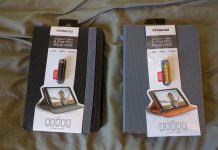 Currently, serious publications like International Business Times are running articles on the Amazon Kindle Fire 7 with subheads like “Loss Leaders.” They argue that: “Amazon is selling an ultra-budget tablet, at close to zero margin, banking on content to bring profits.” That’s such a false argument that it’s hardly worth the effort needed to disprove it. But I’m going to do so anyway.
Currently, serious publications like International Business Times are running articles on the Amazon Kindle Fire 7 with subheads like “Loss Leaders.” They argue that: “Amazon is selling an ultra-budget tablet, at close to zero margin, banking on content to bring profits.” That’s such a false argument that it’s hardly worth the effort needed to disprove it. But I’m going to do so anyway.
All you need to do is look at the hardware shelves. Right now at Best Buy, you can buy a Zeepad 7-inch tablet for as little as $37.05. Or trade up a bit for an Ematic 7-inch tablet for just under $45. And at or just under that magic $49.99 price point you have a slew of devices at Best Buy, including a Haier 9-inch device, as well as the LG G Pad (admittedly under a price-match guarantee). Walmart, meanwhile, sells an RCA Voyager II tablet with Android 5.0 Lollipop for only $49.87, as well as Zeepads, Ematics, and FileMates at even lower price points. But what’s Best Buy’s Number One best-selling tablet? You guessed it: The Amazon Kindle Fire 7.
Point is, none of those no-brand device makers support their manufacturing margins with anything like Amazon’s ad platform and content ecosystem. They depend on hardware sales alone for their profits. They have nothing like Amazon’s name brand recognition and user loyalty. Yet they still manage to turn a buck, and even undercut the new Kindle Fire 7 on price.
Some may argue that the no-brand makers can do that by partnering with the big retail chains. But how is that any different from Amazon? Amazon happens to have the best retail chain going. It’s Amazon right now that is trashing Walmart’s profits and business model, for all the complaints that Amazon itself hardly ever registers a significant profit. Who would you bet on to make a better retail margin on any device sales right now, Amazon or Walmart? No-brainer, right? And the Kindle Fire 7 just happens to be Amazon’s own device. What tablet is it going to push hardest? (And never mind the fact that Amazon can sell its Kindle Fires through Best Buy as well.)
Furthermore, Amazon booked $23 billion in revenue in the second quarter of 2015, according to that same IBT article. Isn’t a company that big and powerful, with all its global relationships and highly developed supply chains, likely to be able to source manufacturing partnerships, and component supply deals, that would put pressure on even its no-brand competitors? No one is saying that the new Kindle Fire 7 is cutting-edge hardware. But it’s good enough at the price. And such a cheap-but-very-cheerful device is likely to have manufacturing costs similar to the low-to-no-brand competition. Especially with the kind of bulk discounts that Amazon’s sales volumes should allow.
Lastly, remember that the Kindle Fire 7’s screamingly low $49.99 price point depends on you buying an ad-supported version. Without the ad-enabled lockscreen, you add on another $15. So Amazon is using its marketing network and relationships from the get-go to push a device with a base $64.99 price point down to a discounted $49.99 – undercutting the cheapo competition once again by delivering superior technology at a price they can’t match.
I didn’t even have to get as far as that last point to falsify the premise that Amazon is digging itself into a hole on manufacturing costs for the new Kindle Fire 7. On top of that, add the draw of Amazon’s content ecosystem. Add the fact that the new device is now Amazon’s cheapest ereader, undercutting all the basic epaper Kindles by quite a bit. Add Amazon’s market reach, brand recognition, sales power, and same-day delivery. All that layers on to probably quite comfortable hardware manufacturing margins to produce a pretty unbeatable offering. Forget the loss part: it’s simply a leader. Deal with it.





























So I went a little nuts in my response to Paul:
http://the-digital-reader.com/2015/10/15/no-amazon-isnt-discarding-its-sell-it-cheap-hardware-strategy/
This was a great article! I have been mostly just using my old Ipod Touch 4G from 2010 to listen to music and finally decided to upgrade to the 6G model that came out last year.
I might end up returning that now, since this Amazon fire tablet sounds like a great deal at a very cheap price! Though i might get the Fire HD 10 model instead. 🙂